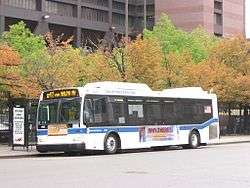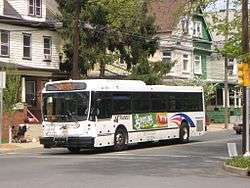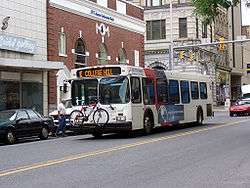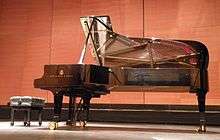Queens Surface Corporation
Queens Surface Corporation was a bus company in New York City, United States, operating local service in Queens and the Bronx and express service between Queens and Manhattan until February 27, 2005, when the MTA Bus Company took over the operations. The company was known for its orange paint scheme, used since the company's inception in the late 1930s.[1][2]
Queens Surface Corporation was privately held by the Burke family.[3] The Queens Surface Corporation facility was located at 128-15 28th Avenue in the College Point neighborhood of Queens.
History
New York and Queens County Railway
The New York and Queens County Railway (NY&QC) became the largest trolley line in Queens in 1896, through the consolidating of four previous streetcar operators: Flushing and College Point Electric Railway, Long Island City and Newtown Railway, Newtown Railway, and the original Steinway Railway Company. It served Long Island City, Woodside, Astoria, North Beach, College Point, Jamaica, and even the Queensboro Bridge. Between 1903 and 1922, the NY&QC became an affiliate of the Interborough Rapid Transit Company.[4] On June 24, 1930., the Woodside Car barn was hit with a massive fire that destroyed much of their fleet, along with the fleet of their competitors, the Steinway Railway (see below).[5]
Steinway Railway
The Steinway Railway operated in northwestern Queens in 1892, through the merger of the Rikers Avenue and Sanford Point Railroad and Steinway and Hunters Point Railroad, only to be acquired by NY&QC in 1896. As NY&QC faced bankruptcy in 1922, it began to sell off Steinway as a somewhat independent company. It was actually bought by the Third Avenue Railway System but was allowed to operate under its own name.
Bustitution and re-merging
On February 19, 1926, NY&QC established a bus division called the Queens-Nassau Transit Lines.[6] Queens-Nassau buses replaced all NY&QC trolleys by 1937, with the last being motorized on October 30 of that year.[5] In the Fall of 1938, the Steinway Railway was bought by Queensboro Bridge Railway Company and renamed as Steinway Omnibus. Steinway began operating buses over former Steinway Railway lines on September 29, 1939.[5] Both companies were operated by the same management,[7] and casually referred to as the "orange buses".[1] Queens-Nassau was renamed Queens Transit Corporation in 1957, and Steinway Omnibus became Steinway Transit in 1959.[8] The two companies merged again in 1986 to form the Queens/Steinway Transit Corporation. The joint company was owned by the Salzberg scrap metal interests, which had ripped up the rails, until 1988, when the Linden Bus Company acquired the routes. Shortly thereafter and before operations commenced, Linden Bus Company changed its name to Queens Surface Corporation.[8]
On February 27, 2005, the MTA Bus Company took over the operations of the Queens Surface routes, part of the city's takeover of all the remaining privately operated bus routes.[9][10]
Bus routes
Prior to MTA Bus takeover, Queens Surface operated the following routes that are now based in College Point Bus Depot, the LaGuardia Depot (the former Triboro Coach depot), and the Eastchester Depot (the former New York Bus Service depot in the Bronx).[11][12]
Former Queens Transit Lines
Bronx and Queens local
- QBx1 Flushing, Pelham Bay Park - Co-op City Limited Stop Service; most service ran exclusively between Pelham Bay Park and Co-op City. Interborough service is now called the Q50. Co-op City shuttle service is now the Bx23.
Queens local
- Q25 Kissena Boulevard/Parsons Boulevard/College Point via 127 Street - Jamaica
- Q34 Kissena Boulevard/Parsons Boulevard/Whitestone via Willets Point Blvd - Jamaica
- Q65 College Point Blvd - 164th Street - Jamaica
- Q65A (Now Q64) Jewel Avenue - Electchester/Hillcrest to Forest Hills
- Q66 Northern Boulevard - (Queens Plaza to Flushing Route)
- Q67 Calvary via Borden Av. (Ridgewood-Long Island City Route)
Queens-Manhattan express
- QM2 Bayside-Whitestone Express, via 6th Avenue or 3rd Avenue
- QM2A (Now QM20) Clearview, Linden & Mitchell Express, via 6th Avenue
- QM3 Deepdale-Douglaston Express, via 6th Avenue
- QM4 Jewel Avenue Express, via 6th Avenue
- QM4 (now QM44) Jewel Avenue Express, via 3rd Avenue
Former Steinway Transit Lines
Queens local
- Q101 Steinway Street - East Midtown
- Q101R (Now Q100) Queens Plaza - Riker's Island Limited Stop Service via 21 Street
- Q102 31st Street - Roosevelt Island - Astoria
- Q103 Vernon Boulevard
- Q104 Broadway - 48th Street - Sunnyside
Queens-Manhattan express
- QM1 Fresh Meadows Express, via 6th Avenue or 3rd Avenue
- QM1 (Now QM7) Fresh Meadows Express to Wall Street via Lower Manhattan loop
- QM1A (Now QM5) Glen Oaks-Windsor Park Express, via 6th Avenue or 3rd Avenue
- QM1A (Now QM6) Lake Success (North Shore Towers) Express, via 6th Avenue or 3rd Avenue
- QM1A (Now QM8) Glen Oaks-Windsor Park Express to Wall Street via Lower Manhattan loop
Depots
Queens Surface depot
Queens Surface's depot was located at 128-15 28th Avenue in the College Point section of Queens, near the printing plant of The New York Times and the former site of Flushing Airport.[13][14][15][16] It was built in 1997 by the NYCDOT, and leased to Queens Surface.[14][17] Many buses under Queens Surface used compressed natural gas (CNG).[13][17] It is now the College Point Depot of the MTA Bus Company.[9][17]
40°46′24″N 73°50′27″W / 40.773378°N 73.840804°W
Steinway Transit depot
The Steinway Transit depot, built in 1939, was located at the northwest corner of Steinway Street and 20th Avenue in Astoria, Queens, near the northern terminus of the company's Q101 route.[7][18][19] It was the successor to the Steinway Railway depot.[5] The trolley depot sat across from the Daimler Manufacturing Company automobile factory, opened in 1890 by Gottlieb Daimler and local businessman William Steinway.[20][21][22] The bus depot was closed prior to the company's takeover by the city.
40°46′36″N 73°54′06″W / 40.776744°N 73.901683°W
Woodside Garage
The Woodside Garage was located at 51-00 Northern Boulevard, at the southeast corner 51st Street and Northern Boulevard in Woodside, Queens, adjacent to the Winfield Junction of the Long Island Rail Road. It was the original headquarters of Queens-Nassau Transit.[7][23] It was also the successor to the NY&QC Woodside Trolley Barn, which opened in 1896 and burned down on June 24, 1930.[5][24] The front facade of the trolley barn survives as a Pizza Hut restaurant of the Tower Square Shopping Center.[24]
40°45′10″N 73°54′36″W / 40.752684°N 73.910128°W
References
- 1 2 "Roberts Out as the Boss of Orange Buses" (PDF). Long Island Daily Press. Fultonhistory.com. 1941. Retrieved 2 March 2016.
- ↑ Greenhouse, Steven (January 8, 2002). "Surprise Bus Strike in Queens Forces 120,000 to Scramble". The New York Times. Retrieved 2 March 2016.
- ↑ Chan, Sewell (2005-02-01). "City Will Pay $9.5 Million for Bus Line in Queens". New York Times. Retrieved 2010-01-22.
- ↑ New York and Queens County Railway Waiting Room (Long Island Stations & Structures, by Paul S. Luchter; TrainWeb)
- 1 2 3 4 5 Seyfried, Vincent F. (1950). "Full text of "New York and Queens County Railway and the Steinway Lines, 1867-1939."". archive.org. Vincent F. Seyfried. Retrieved 20 December 2015.
- ↑ "Full text of 'State of New York Department of Public Service Metropolitan Division: Fourteenth Annual Report For the Calendar Year 1934'"". archive.org. New York State Department of Public Service. February 14, 1935. Retrieved 2 March 2016.
- 1 2 3 "Bus Strike Talks Break Down: Tie-up Tomorrow Appears Certain" (PDF). Long Island Star-Journal. Fultonhistory.com. July 12, 1946. p. 1. Retrieved 2 March 2016.
- 1 2 Roger P. Roess; Gene Sansone (23 August 2012). The Wheels That Drove New York: A History of the New York City Transit System. Springer Science & Business Media. pp. 416–417. ISBN 978-3-642-30484-2.
- 1 2 Silverman, Norman (July 26, 2010). "The Merger of 7 Private Bus Companies into MTA Bus" (PDF). apta.com. American Public Transportation Association, Metropolitan Transportation Authority. Archived (PDF) from the original on 2015-10-16. Retrieved 16 October 2015.
- ↑ Woodberry, Jr., Warren (February 24, 2005). "MAJOR BUS CO. TO JOIN MTA". Daily News (New York). Retrieved 4 January 2016.
- ↑ Queens Surface Corp: Employment (via the Internet Archive)
- ↑ "MTA Bus: LaGuardia Pick Glossary" (PDF). lgaunion.com. MTA Bus Company. January 3, 2016. Retrieved 2 March 2016.
- 1 2 Urbitran Associates, Inc (May 2004). "NYCDOT Bus Ridership Survey and Route Analysis Final Report: Chapter 3 Transit System Characteristics" (PDF). nyc.gov. New York City Department of Transportation. Retrieved 16 October 2015.
- 1 2 "Police Academy – College Point, Queens FEIS CHAPTER 7: HAZARDOUS MATERIALS" (PDF). nyc.gov. New York City Police Department. Retrieved 16 October 2015.
- ↑ Queens Surface Corporation homepage; including address (Internet Archive)
- ↑ New York Times College Point Complex and vicinity (Wikimapia)
- 1 2 3 For Release (April 7, 2006). "Trillium Expands New York City Operations: New Contract Signed with MTA Bus Company". Integrys Energy Group. Salt Lake City, Utah. Retrieved 2 March 2016.
- ↑ "Buses To Replace Four Trolley Lines Next Month; Steinway St. Motor Route Meets Delay; Queensboro Bridge Cars To Continue To Permit Stops At Island." (PDF). Long Island Star-Journal. Fultonhistory.com. September 9, 1989. p. 1. Retrieved 1 March 2016.
- ↑ DeJong, Herman D. (June 22, 1981). "Crime and Punishment". New York (magazine). Retrieved 2 March 2016.
- ↑ Bindelglass, Evan (March 21, 2014). "Parsing The Steinway Mansion's Rich Past & Uncertain Future". Curbed. Retrieved 2 March 2016.
- ↑ Barron, James (July 19, 2003). "Today's Pianos Have Prelude In Yesterday's; Steinway Family Legacy Pervades Factory in Queens". The New York Times. Retrieved 2 March 2016.
- ↑ A. J. Jacobs (16 December 2015). The New Domestic Automakers in the United States and Canada: History, Impacts, and Prospects. Lexington Books. pp. 22–23. ISBN 978-0-7391-8826-2. Retrieved 1 March 2016.
- ↑ "Bus Drivers End 'Sick' Strike; Service Restored On 'Orange' Lines; Union Orders Arbitration Of Dispute" (PDF). Long Island Star-Journal. Fultonhistory.com. November 17, 1945. p. 1. Retrieved 2 March 2016.
- 1 2 Walsh, Kevin (September 15, 1998). "WOODSIDE'S TROLLEY BARN". Forgotten New York. Retrieved 2 March 2016.
- Lost Trolleys of Queens and Long Island by Stephen L. Meyers, 2006
External links
- Queens Surface Corp (via the Internet Archive)
- New York and Queens County Railway and the Steinway Lines, 1867-1939, Internet Archive
- Chicago Transit & Railfan Web Site: New York City Transit
- Trolley Barn with Anchovies: Woodside's Trolley Terminal (Forgotten New York)




.jpg)

